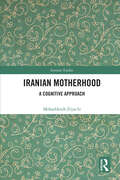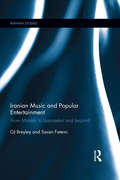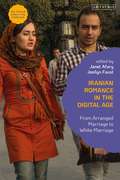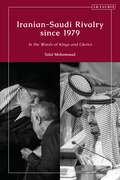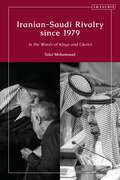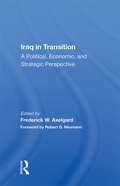- Table View
- List View
Iranian Motherhood: A Cognitive Approach (Iranian Studies)
by Mohaddeseh ZiyachiThis book characterises the problematic status of motherhood in present-day Iranian society – that is, problem in the Foucauldian sense of an object of thought and a source of tension, not as a pathological issue – and explains the historical processes contributing to this problematisation. Taking an interdisciplinary approach, the author draws on a cognitive anthropological perspective whilst incorporating ethnographic, historical, and evolutionary viewpoints. By applying this perspective to the current cultural model of motherhood, and considering specific social, political, and economic factors in Iran, the author provides an exhaustive, contextualised understanding of the motherhood problem and its multidirectional changes throughout time. The book follows a multi-method framework and combines qualitative ethnographic and auto-ethnographic data with historical evidence and comparative data. As such, it also contributes to the women's movement in Iran by fostering discussion on women's issues and demystifying women's understandings and experiences. The book will appeal to those working in a range of disciplines, including gender studies, cognitive anthropology and Iranian history. Written in non-technical language, and providing insights into the problem of motherhood in comparable contexts, the book will also be of interest to general readers.
Iranian Music and Popular Entertainment: From Motrebi to Losanjelesi and Beyond (Iranian Studies)
by Sasan Fatemi GJ BreyleyThe word motreb finds its roots in the Arabic verb taraba, meaning ‘to make happy.’ Originally denoting all musicians in Iran, motrebi came to be associated, pejoratively, with the cheerful vulgarity of the lowbrow entertainer. In Iranian Music and Popular Entertainment, GJ Breyley and Sasan Fatemi examine the historically overlooked motrebi milieu, with its marginalized characters, from luti to gardan koloft and mashti, as well as the tenacity of motreb who continued their careers against all odds. They then turn to losanjelesi, the most pervasive form of Iranian popular music that developed as motrebi declined, and related musical forms in Iran and its diasporic popular cultural centre, Los Angeles. For the first time in English, the book makes available musical transcriptions, analysis and lyrics that illustrate the complexities of this history. As it presents the findings of the authors’ years of ethnographic work with the history’s protagonists, from senior motreb to pop-rock stars, the book reveals parallels between the decline of motrebi and the rise of ‘modernity.’ In the twentieth century, the fate of Tehran’s motrebi music was shaped by the social and urban polarization that ensued from the modern market economy, and losanjelesi would be similarly affected by transnational relations, revolution, war and migration. Through its detailed and informed examination of Iranian popular music, this study reveals much about the values and anxieties of Iranian society, and is a valuable resource for students and scholars of Iranian society and history.
Iranian Music and Popular Entertainment: From Motrebi to Losanjelesi and Beyond (Iranian Studies)
by Sasan Fatemi GJ BreyleyThe word motreb finds its roots in the Arabic verb taraba, meaning ‘to make happy.’ Originally denoting all musicians in Iran, motrebi came to be associated, pejoratively, with the cheerful vulgarity of the lowbrow entertainer. In Iranian Music and Popular Entertainment, GJ Breyley and Sasan Fatemi examine the historically overlooked motrebi milieu, with its marginalized characters, from luti to gardan koloft and mashti, as well as the tenacity of motreb who continued their careers against all odds. They then turn to losanjelesi, the most pervasive form of Iranian popular music that developed as motrebi declined, and related musical forms in Iran and its diasporic popular cultural centre, Los Angeles. For the first time in English, the book makes available musical transcriptions, analysis and lyrics that illustrate the complexities of this history. As it presents the findings of the authors’ years of ethnographic work with the history’s protagonists, from senior motreb to pop-rock stars, the book reveals parallels between the decline of motrebi and the rise of ‘modernity.’ In the twentieth century, the fate of Tehran’s motrebi music was shaped by the social and urban polarization that ensued from the modern market economy, and losanjelesi would be similarly affected by transnational relations, revolution, war and migration. Through its detailed and informed examination of Iranian popular music, this study reveals much about the values and anxieties of Iranian society, and is a valuable resource for students and scholars of Iranian society and history.
The Iranian Political Language: From the Late Nineteenth Century to the Present
by Yadullah ShahibzadehIn this detailed study of modern Iran, Yadullah Shahibzadeh examines changes in people's understanding of politics and democracy. The book aims to overcome the shortcomings of traditional historiography by challenging the monopoly of intellectuals' perspectives and demonstrating the intellectual and political agency of the ordinary people.
Iranian Refugees in Transit: Exile and the Politics of Survival in Turkey after the 1979 Revolution
by Maral JefroudiMaral Jefroudi presents a comprehensive picture of one of the largest migration waves in contemporary history by analyzing refugees' interactions with the Turkish State, the UNHCR, and within the community of Iranians in transit after the 1979 revolution.Iranian Refugees in Transit unveils the rich history of political engagement among Iranian refugees before their arrival in Turkey, contextualised within Turkey's own landscape of political and ethnic conflicts. Jefroudi expertly examines the intersectional distribution of precarity among refugees. By bringing together interviews with refugees from the period, analyzing cultural products by and on them, and tracing their footsteps in newspapers and scholarly literature, this book fills a significant gap in Turkey's migration history. Through a critical historical analysis of the international asylumsystem, Iranian Refugees in Transit offers valuable insights into the dynamics of the current 'refugee crisis'.
Iranian Refugees in Transit: Exile and the Politics of Survival in Turkey after the 1979 Revolution
by Maral JefroudiMaral Jefroudi presents a comprehensive picture of one of the largest migration waves in contemporary history by analyzing refugees' interactions with the Turkish State, the UNHCR, and within the community of Iranians in transit after the 1979 revolution.Iranian Refugees in Transit unveils the rich history of political engagement among Iranian refugees before their arrival in Turkey, contextualised within Turkey's own landscape of political and ethnic conflicts. Jefroudi expertly examines the intersectional distribution of precarity among refugees. By bringing together interviews with refugees from the period, analyzing cultural products by and on them, and tracing their footsteps in newspapers and scholarly literature, this book fills a significant gap in Turkey's migration history. Through a critical historical analysis of the international asylumsystem, Iranian Refugees in Transit offers valuable insights into the dynamics of the current 'refugee crisis'.
The Iranian Revolution Then And Now: Indicators Of Regime Instability
by Dariush ZahediIn The Iranian Revolution Then and Now , Dariush Zahedi assesses the Islamic Republic's potential for revolution through an in-depth, theoretically informed, comparative analysis of the present with 1979 pre-Revolutionary Iran. Zahedi discusses how the potential for a revolutionary coup is based on two things: the inherent defects and vulnerabilities in the regime and the coordinated actions of the social groups and individuals opposed to the regime. He also identifies two ideal-typical forms of revolutionary change. }In The Iranian Revolution Then and Now , Dariush Zahedi assesses the Islamic Republic's potential for revolution through an in-depth, theoretically informed, comparative analysis of the present with 1979 pre-Revolutionary Iran. Zahedi discusses how the potential for a revolutionary coup is based on two things: the inherent defects and vulnerabilities in the regime and the coordinated actions of the social groups and individuals opposed to the regime. He also identifies two ideal-typical forms of revolutionary change (the regime collapses on its own, or, the regime is overthrown). He concludes that the chances for overthrowing the present regime are moderate. }
Iranian Romance in the Digital Age: From Arranged Marriage to White Marriage (Sex, Family and Culture in the Middle East)
by Janet Afary and Jesilyn FaustFollowing the 1979 Islamic Revolution, there was a dramatic reversal of women's rights, and the state revived many premodern social conventions through modern means and institutions. Customs such as the enforced veiling of women, easy divorce for men, child marriage, and polygamy were robustly reintroduced and those who did not conform to societal strictures were severely punished. At the same time, new social and economic programs benefited the urban and rural poor, especially women, which had a direct impact on gender relations and the institution of marriage.Edited by Janet Afary and Jesilyn Faust, this interdisciplinary volume responds to the growing interest and need for literature on gender, marriage and family relations in the Islamic context. The book examines how the institution of marriage transformed in Iran, paying close attention to the country's culture and politics. Part One examines marital changes in the rural and tribal sectors of society through the works of anthropologists Erika Friedl and Mary Hegland. Part Two turns its eye to look at changes in urban marriages to new forms of cohabitation. In Part Three, the contributors explore the way technology and social media has impacted and altered the institution of family. Based on the work of new and established scholars, the collection provides an up-to-date study of an important and intensely politicized subject.
Iranian Romance in the Digital Age: From Arranged Marriage to White Marriage (Sex, Family and Culture in the Middle East)
Following the 1979 Islamic Revolution, there was a dramatic reversal of women's rights, and the state revived many premodern social conventions through modern means and institutions. Customs such as the enforced veiling of women, easy divorce for men, child marriage, and polygamy were robustly reintroduced and those who did not conform to societal strictures were severely punished. At the same time, new social and economic programs benefited the urban and rural poor, especially women, which had a direct impact on gender relations and the institution of marriage.Edited by Janet Afary and Jesilyn Faust, this interdisciplinary volume responds to the growing interest and need for literature on gender, marriage and family relations in the Islamic context. The book examines how the institution of marriage transformed in Iran, paying close attention to the country's culture and politics. Part One examines marital changes in the rural and tribal sectors of society through the works of anthropologists Erika Friedl and Mary Hegland. Part Two turns its eye to look at changes in urban marriages to new forms of cohabitation. In Part Three, the contributors explore the way technology and social media has impacted and altered the institution of family. Based on the work of new and established scholars, the collection provides an up-to-date study of an important and intensely politicized subject.
Iranian-Saudi Rivalry since 1979: In the Words of Kings and Clerics
by Talal MohammadThe fraught relationship between Saudi Arabia and Iran is usually attributed to sectarian differences, even by the states' own elites. However, this book shows that in their official speeches, newspaper editorials and Friday sermons, these elites use sectarian and nationalist references and tropes to denigrate each other and promote themselves in the eyes of their respective constituencies in the region. Talal Mohammad, who is fluent in both Arabic and Persian, examines Saudi-Iranian rivalry using discourse analysis of these religious, political and journalistic sources. Tracing what has been produced since 1979 in parallel, he argues for a consistent pattern of mutual misrepresentation, whereby each frames its counterpart as the 'Other' to which a specific political agenda can be justified and advanced. The book covers key events including the Iranian Revolution, the invasion of Kuwait in 1990, the Taliban war, the fall of Saddam, the Arab Spring, the rise of Mohammed bin Salman, and the war on ISIS. While until now Saudi-Iranian rivalry has been understood in primarily sectarian or geopolitical terms, the author argues here that the discursive othering serves as a propagandist function that supports more fundamental political and geopolitical considerations.
Iranian-Saudi Rivalry since 1979: In the Words of Kings and Clerics
by Talal MohammadThe fraught relationship between Saudi Arabia and Iran is usually attributed to sectarian differences, even by the states' own elites. However, this book shows that in their official speeches, newspaper editorials and Friday sermons, these elites use sectarian and nationalist references and tropes to denigrate each other and promote themselves in the eyes of their respective constituencies in the region. Talal Mohammad, who is fluent in both Arabic and Persian, examines Saudi-Iranian rivalry using discourse analysis of these religious, political and journalistic sources. Tracing what has been produced since 1979 in parallel, he argues for a consistent pattern of mutual misrepresentation, whereby each frames its counterpart as the 'Other' to which a specific political agenda can be justified and advanced. The book covers key events including the Iranian Revolution, the invasion of Kuwait in 1990, the Taliban war, the fall of Saddam, the Arab Spring, the rise of Mohammed bin Salman, and the war on ISIS. While until now Saudi-Iranian rivalry has been understood in primarily sectarian or geopolitical terms, the author argues here that the discursive othering serves as a propagandist function that supports more fundamental political and geopolitical considerations.
Iran's Diverse Peoples: A Reference Sourcebook (Ethnic Diversity Within Nations)
by Massoume PriceSpanning a 5,000-year period, this is the first work to document the origins, evolution, and current status of all major ethnic groups in Iran.From ancient civilizations of 3000 B.C. to the election of President Mohammad Khatami five millennia later, Iran's history is a rich palette of conquests, invasions, occupations, and revolutions. Iran's Diverse Peoples: A Reference Sourcebook documents for the first time the major ethnic groups that emerged during each era and traces their evolution to the present day.Written by a social anthropologist educated in Iran and England, this analysis presents vital statistics on the Persians, Kurds, Turks, Lurs, Assyrians, Arabs, and other pastoral and urban groups of Iran, highlighting their differing languages, religions, cultural practices, political agendas, and current problems. The settling of nomadic tribes, the unveiling of women, the Islamic Revolution, OPEC, Soviet intervention, Kurdish oppression—these and other contentious topics are all examined with respect to their impact on Iran's ethnic entities.
Iran's Foreign Policy in the South Caucasus: Relations with Azerbaijan and Armenia (Durham Modern Middle East and Islamic World Series)
by Marzieh Kouhi-EsfahaniIran’s role as a regional power is more significant than many in the West may realise. The country lies between Central Asia/the Caucasus and the Gulf region on the one hand, and, on the other, between the Mediterranean/Levant region and South Asia. Many of these areas are of increasing strategic importance. This book explores Iran’s role as a regional power, focusing on relations with South Caucasus countries - Azerbaijan and Armenia. It outlines the historical context, including Persia’s rule of these countries before the nineteenth century, and discusses Iran’s approach to foreign and regional policy and how both internal and international factors shape these policies. The book assesses Iran–Azerbaijan and Iran–Armenia bilateral relations to demonstrate how those policies translate in Iran's regional and bilateral relations. The book concludes by considering how Iran's relations in the region are likely to develop in the future.
Iran's Foreign Policy in the South Caucasus: Relations with Azerbaijan and Armenia (Durham Modern Middle East and Islamic World Series)
by Marzieh Kouhi-EsfahaniIran’s role as a regional power is more significant than many in the West may realise. The country lies between Central Asia/the Caucasus and the Gulf region on the one hand, and, on the other, between the Mediterranean/Levant region and South Asia. Many of these areas are of increasing strategic importance. This book explores Iran’s role as a regional power, focusing on relations with South Caucasus countries - Azerbaijan and Armenia. It outlines the historical context, including Persia’s rule of these countries before the nineteenth century, and discusses Iran’s approach to foreign and regional policy and how both internal and international factors shape these policies. The book assesses Iran–Azerbaijan and Iran–Armenia bilateral relations to demonstrate how those policies translate in Iran's regional and bilateral relations. The book concludes by considering how Iran's relations in the region are likely to develop in the future.
Iraq: The Search for National Identity
by Liora LukitzThe 1990-1991 crisis in the Middle East and the disturbances that followed, threw the deep-seated divisions within the Iraqi population into focus. This book examines the complexities of the internal cultural, political and religious conflict within the modern state of Iraq.
Iraq: The Search for National Identity
by Liora LukitzThe 1990-1991 crisis in the Middle East and the disturbances that followed, threw the deep-seated divisions within the Iraqi population into focus. This book examines the complexities of the internal cultural, political and religious conflict within the modern state of Iraq.
Iraq From Manadate Independence
by Ernest MainOriginally published in 1935 and reprinted now because of its current political relevance, this work concentrates on the events which led to the 1932 installation of Faisal as King of Iraq at the termination of the British Mandate. Though it deals chiefly with politics at the time, the book also offers important insights into current developments in Iraq and their historical significance. Anyone interested in the future of Iraq and the Middle East at large will find this a compelling read.
Iraq From Manadate Independence: From Mandate To Independence
by Ernest MainOriginally published in 1935 and reprinted now because of its current political relevance, this work concentrates on the events which led to the 1932 installation of Faisal as King of Iraq at the termination of the British Mandate. Though it deals chiefly with politics at the time, the book also offers important insights into current developments in Iraq and their historical significance. Anyone interested in the future of Iraq and the Middle East at large will find this a compelling read.
Iraq - From War to a New Authoritarianism (Adelphi Ser.)
by Toby DodgeIraq recovered its full sovereignty at the end of 2011, with the departure of all US military forces. The 2003 invasion was undertaken to dismantle a regime that had long threatened its own population and regional peace, as well as to establish a stable, democratic state in the heart of the Middle East. This Adelphi looks at the legacy of that intervention and subsequent state-building efforts. It analyses the evolution of the insurgency, the descent into full-scale civil war and the implementation of the ‘surge’ as a counterinsurgency strategy. It goes on to examine US and Iraqi efforts to reconstruct the state’s military and civilian capacity. By developing a clear understanding of the current situation in Iraq, this book seeks to answer three questions that are central to the country’s future. Will it continue to suffer high levels of violence or even slide back into a vicious civil war? Will Iraq continue on a democratic path, as exemplified by the three competitive national elections held since 2005? And does the new Iraq pose a threat to its neighbours?
Iraq - From War to a New Authoritarianism (Adelphi Ser.)
by Toby DodgeIraq recovered its full sovereignty at the end of 2011, with the departure of all US military forces. The 2003 invasion was undertaken to dismantle a regime that had long threatened its own population and regional peace, as well as to establish a stable, democratic state in the heart of the Middle East. This Adelphi looks at the legacy of that intervention and subsequent state-building efforts. It analyses the evolution of the insurgency, the descent into full-scale civil war and the implementation of the ‘surge’ as a counterinsurgency strategy. It goes on to examine US and Iraqi efforts to reconstruct the state’s military and civilian capacity. By developing a clear understanding of the current situation in Iraq, this book seeks to answer three questions that are central to the country’s future. Will it continue to suffer high levels of violence or even slide back into a vicious civil war? Will Iraq continue on a democratic path, as exemplified by the three competitive national elections held since 2005? And does the new Iraq pose a threat to its neighbours?
Iraq in the Twenty-First Century: Regime Change and the Making of a Failed State (Durham Modern Middle East and Islamic World Series)
by Tareq Y. Ismael Jacqueline S. IsmaelMuch has been written about the events surrounding the 2003 Anglo-American invasion of Iraq and its aftermath, especially about the intentions, principles, plans and course of action of US policy, but much less attention has been given to the consequences of US policy on Iraqi political and social development. This book provides an in-depth analysis of the impact of US policy on the social and political development of Iraq in the twenty-first century. It shows how not just the institutions of the state were destroyed in 2003, leaving the way open for sectarianism, but also the country’s cultural integrity, political coherence, and national-oriented economy. It outlines how Iraq has been economically impoverished, assessing the appalling situation which ordinary people, including women and children, have endured, not just as a result of the 2003 war, but also as a consequence of the 1991 war and the sanctions imposed in the following years. The book argues that the social, political, and cultural ruin that accompanied the Iraq war was an absolute catastrophe; that the policies which had such adverse effects were the foreseeable consequences of deliberate policy choices; and that those responsible continue to evade being made accountable.
Iraq in the Twenty-First Century: Regime Change and the Making of a Failed State (Durham Modern Middle East and Islamic World Series)
by Tareq Y. Ismael Jacqueline S. IsmaelMuch has been written about the events surrounding the 2003 Anglo-American invasion of Iraq and its aftermath, especially about the intentions, principles, plans and course of action of US policy, but much less attention has been given to the consequences of US policy on Iraqi political and social development. This book provides an in-depth analysis of the impact of US policy on the social and political development of Iraq in the twenty-first century. It shows how not just the institutions of the state were destroyed in 2003, leaving the way open for sectarianism, but also the country’s cultural integrity, political coherence, and national-oriented economy. It outlines how Iraq has been economically impoverished, assessing the appalling situation which ordinary people, including women and children, have endured, not just as a result of the 2003 war, but also as a consequence of the 1991 war and the sanctions imposed in the following years. The book argues that the social, political, and cultural ruin that accompanied the Iraq war was an absolute catastrophe; that the policies which had such adverse effects were the foreseeable consequences of deliberate policy choices; and that those responsible continue to evade being made accountable.
Iraq In Transition: A Political, Economic, And Strategic Perspective
by Frederick W AxelgardAfter twenty-five years of thinly veiled hostility, U.S. relations with post-monarchial Iraq have warmed dramatically. Simultaneously, Iraq's sovereignty has become the keystone of Gulf stability, due to Iraq's military and economic resilience and to the rise of Khomeini's Iran and the waning of Saudi influence. In this book, five leading analysts
Iraq In Transition: A Political, Economic, And Strategic Perspective
by Frederick W AxelgardAfter twenty-five years of thinly veiled hostility, U.S. relations with post-monarchial Iraq have warmed dramatically. Simultaneously, Iraq's sovereignty has become the keystone of Gulf stability, due to Iraq's military and economic resilience and to the rise of Khomeini's Iran and the waning of Saudi influence. In this book, five leading analysts
Iraq since the Invasion: People and Politics in a State of Conflict
by Keiko SakaiThis book addresses the complex events and unexpected outcomes of military intervention by the United States and its allies in Iraq in 2003. Considering the long-term outcomes of the intervention, this volume examines economic collapse, societal disorder, and increased regional conflict in Iraq. The book assesses the means by which American strategists imposed a new political order, generalising corruption, sectarian preference, and ethnic cleansing, and stimulating mass population movements in and from Iraq. Mobilising a multidisciplinary perspective, the book explores the rise and fall of Iraq’s confessional leaders, the emergence of a popular movement for reform, and the demands of young radicals focused upon revolutionary change. The product of years of intensive research by Iraqis and international scholars, Iraq since the Invasion considers how an initiative designed to produce “regime change” favourable to the United States and its allies brought unprecedented influence for Iran—both in Iraq and the wider Gulf region. It analyses events in Kurdistan and the impacts of change on relations between Iraq and its neighbours. The book includes a wealth of detail on political, social, and cultural change, and on the experiences of Iraqis during long years of upheaval. It will be of value to researchers and students interested in international relations, development studies, and Middle East politics.
